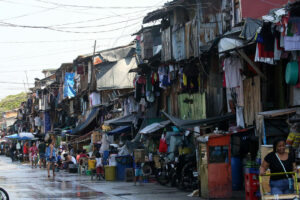




Philippines Trade Update: Trade trajectories trend along
 DOWNLOAD
DOWNLOAD

Policy Rate Updates: Double cut finale
 DOWNLOAD
DOWNLOAD

Monthly Economic Update: One for the road
 DOWNLOAD
DOWNLOAD


Inclusive growth key to lower poverty incidence — Balisacan

The Philippine Government is banking on increased investments in the manufacturing and services sectors to make growth more inclusive and lift more Filipinos out of poverty by 2028, the National Economic and Development Authority (NEDA) said.
“Inequality of opportunities is what we want to reduce — whether that inequality is in the form of access to education, health, wealth, credit, technology,” NEDA Secretary Arsenio M. Balisacan told BusinessWorld last week.
The country’s poverty rate fell to 15.5% in 2023 from 18.1% in 2021, the Philippine Statistics Authority (PSA) said. The number of poor Filipinos declined by 12.26% to 17.54 million in 2023 from 19.99 million in 2021.
The government is aiming to reduce poverty incidence to 9% by 2028 or the end of the Marcos administration.
To be able to achieve this target, around seven million Filipinos must be lifted out of poverty annually in the next four years, NEDA said.
This would be possible if economic growth in the next few years is sustained and inclusive, Mr. Balisacan said.
The Philippine economy is expected to grow by 6-7% this year and 6.5-7.5% next year. It also expects gross domestic product (GDP) growth at 6.5-8% from 2026 to 2028.
“When we say more inclusive, technically, it means the Gini (coefficient) ratio will fall or will at least remain the same… If it will increase, it weakens the impact of economic growth,” Mr. Balisacan said.
The Gini coefficient, which measures how unevenly distributed a country’s annual income is, fell to 0.3909 in 2023 from 0.4063 in 2021. A Gini coefficient reading of “0” suggests perfect equality, while “1” denotes perfect inequality.
Mr. Balisacan also highlighted the need for the “structural transformation of the economy” by increasing the value of high productivity sectors such as manufacturing, services, and tourism.
“If you can infuse even more dynamism into the services sector, this is where the people will go,” he said.
As an example, integrating the medical technology sector with the business process outsourcing (BPO) industry could also help create more job opportunities, Mr. Balisacan said.
“Since we’re a global supplier of nurses and doctors, and if we can get the medtech (medical technology) industry here in conjunction with a strong BPO, you can have a very strong pillar of poverty reduction and economic growth,” he said.
‘UNREALISTIC’ THRESHOLD
Meanwhile, IBON Foundation Executive Director Jose Enrique A. Africa said the improved poverty rate is not the result of the creation of more productive and high-paying jobs.
“It is for instance striking that job creation accompanying recent supposedly rapid economic growth is mostly in low-paying and low-productivity sectors that are notorious for informality,” he said in a Viber message.
Mr. Africa also noted that the poverty threshold used by the PSA remains “low and unrealistic,” and was likely offset by the expansion of social protection or ayuda programs.
The poverty threshold or the minimum income needed to meet the basic food and nonfood requirements of a family of five is currently at PHP 13,873 per month, PSA data showed.
The food threshold or the minimum income needed by a family of five to meet their monthly basic food needs was at PHP 9,581 or about PHP 64 per person per day.
Ateneo de Manila University economics professor Leonardo A. Lanzona said that people who are considered above the poverty threshold but receive government subsidies are still vulnerable to economic shocks.
“We have this huge category of nonpoor people hovering just above the threshold. Because of this, any economic shock such as high inflation or COVID-19 (coronavirus disease 2019) can result in substantial increases again in poverty, making it very difficult to reduce poverty permanently to single-digit levels,” he said in a Facebook Messenger chat.
The government must focus on developing the domestic agriculture and industry sectors to ensure “truly sustainable and inclusive” growth, Mr. Africa said.
Last week, Mr. Balisacan defended the use of these poverty and food thresholds, saying these are metrics used to determine the inclusiveness of economic growth and the effectiveness of policies.
“They are not, and were never intended to be, prescribed budgets for a decent standard of living. They do not dictate how much a family should spend on food, nor do they provide an idea of a desirable household budget,” he said in a statement. – Beatriz Marie D. Cruz, Reporter
This article originally appeared on bworldonline.com





 By BusinessWorld
By BusinessWorld